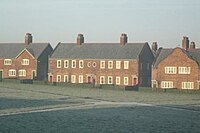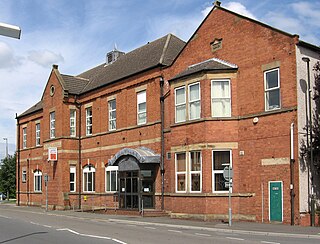
Staveley is a town and civil parish in the Borough of Chesterfield, Derbyshire, England. Located along the banks of the River Rother. It is northeast of Chesterfield, west of Clowne, northwest of Bolsover, southwest of Worksop and southeast of Sheffield.
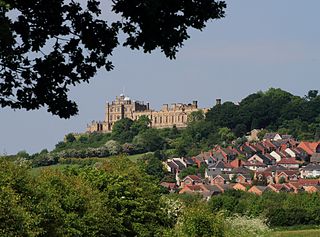
Bolsover is a market town and the administrative centre of the Bolsover District, Derbyshire, England. It is 18 miles (29 km) from Sheffield, 26 miles (42 km) from Nottingham and 27 miles (43 km) from Derby. It is the main town in the Bolsover district.

A model village is a type of mostly self-contained community, built from the late 18th century onwards by landowners and business magnates to house their workers. Although the villages are located close to the workplace, they are generally physically separated from them and often consist of relatively high-quality housing, with integrated community amenities and attractive physical environments. "Model" is used in the sense of an ideal to which other developments could aspire.

Shirebrook is a town in the Bolsover district of Derbyshire, England, near Mansfield and Bassetlaw in Nottinghamshire, it had a population of 9,760 at the 2011 Census. It is on the B6407, close to the A632 road, between Mansfield and Bolsover.

A pit village, colliery village or mining village is a settlement built by colliery owners to house their workers. The villages were built on the coalfields of Great Britain during the Industrial Revolution where new coal mines were developed in isolated or unpopulated areas. Such settlements were developed by companies for the incoming workers.

Percy Bond Houfton (1873–1926) was a late-19th century and early-20th century English architect.

Clowne is a village and civil parish in the Bolsover district of Derbyshire, England. The population was 7,590 at the 2011 Census. It lies 9 miles (14 km) north east of Chesterfield and 7 miles (11 km) south west of Worksop and is mentioned in the Domesday Book as Clune. The name is derived from the Celtic Clun for a river.

Creswell is a former mining village located in the Bolsover district of Derbyshire, England. At the 2011 Census population details were included in the civil parish of Elmton-with-Creswell. Today it is best known for Creswell Crags and its model village. In September 1950 Creswell Colliery was the scene of one of the worst post-nationalisation mining disasters. Elmton Common is an area of allotments for the township of Creswell.

Belph is a hamlet in the parish of Hodthorpe and Belph, within the district of Bolsover, in the county of Derbyshire, England. It is part of the Welbeck Abbey Estate, on the edge of modern-day Sherwood Forest. The village is 1 mile (1.6 km) south-east of Hodthorpe, 1 mile (1.6 km) south-east of Whitwell and 3 miles (4.8 km) south-west of Worksop. The village is the easternmost settlement in Derbyshire.

Elmton with Creswell is a civil parish in the Bolsover district in Derbyshire, England. It covers the villages of Elmton, Creswell and Creswell Model Village. According to Census data in 2001, Elmton with Creswell parish had a population of 4,755, and in 2011 had a population of 5,550. The town lies on the border with Nottinghamshire.
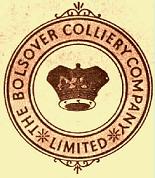
The Bolsover Colliery Company was a major mining concern established to extract coal from land owned by the Duke of Portland. At its peak the business was a constituent of the FT 30 index of leading companies on the London Stock Exchange.

Hodthorpe is an urban village in the parish of Hodthorpe and Belph, Bolsover, Derbyshire, lying close to the Nottinghamshire border and on the edge of Sherwood Forest. The village has two principal streets, Queens Road and Kings Street. It has one shop, a village primary school, and a Working Men's club. There are two parks.
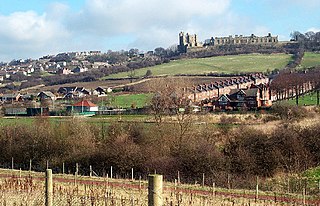
New Bolsover model village is a village adjoining the town of Bolsover in Derbyshire.
The Lancashire, Derbyshire and East Coast Railway (LD&ECR) was built to connect coalfields in Derbyshire and Nottinghamshire with Warrington and a new port on the Lincolnshire coast. It was a huge undertaking, and the company was unable to raise the money to build its line. With the financial help of the Great Eastern Railway it managed to open between Chesterfield and Lincoln with a branch towards Sheffield from 1896. Despite efforts to promote tourist travel, the passenger business was never buoyant, but collieries were connected to the line, at first and in succeeding years. The Great Eastern Railway, and other main line companies, transported coal to the southern counties, and the company's engines took coal to Immingham in great quantities. The company had a fleet of tank engines.

Arkwright Town railway station was in Arkwright Town, Derbyshire, England.
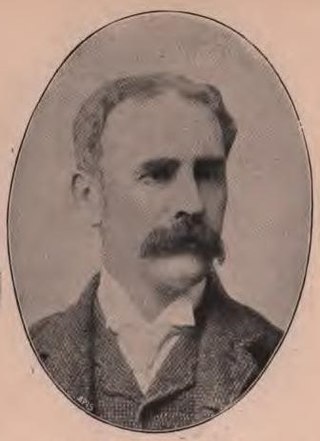
Emerson Muschamp Bainbridge was an English mining consulting engineer, philanthropist and Liberal Party politician who sat in the House of Commons from 1895 to 1900.

Staveley Town is a disused railway station in Staveley, Derbyshire in England.
The Clowne Branch is a disused railway line in north eastern Derbyshire, England. Which runs from Creswell to Staveley. Historically it ran to Chesterfield. It is now in use as a greenway.
The Doe Lea branch is a mothballed railway line in Derbyshire, England. It connected the Derbyshire towns of Chesterfield, Staveley and Bolsover to the Nottinghamshire town of Mansfield. It also had a branch line to Creswell via the Derbyshire town of Clowne.

Hodthorpe and Belph is a civil parish within the Bolsover district, of the county of Derbyshire, England. The parish includes the village of Hodthorpe and the hamlet of Belph. In 2011 the parish had a population of 663. It is 132 miles north west of London, 27 miles north east of the county city of Derby, and 5 miles north east of the market town of Bolsover. The parish touches Welbeck, Whitwell, Elmton with Creswell and Holbeck, and is the easternmost in Derbyshire. There is one listed building in Hodthorpe and Belph.
